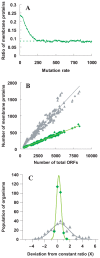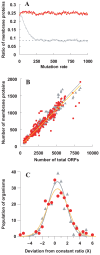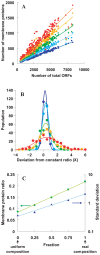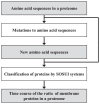Ratio of membrane proteins in total proteomes of prokaryota
- PMID: 27857565
- PMCID: PMC5036657
- DOI: 10.2142/biophysics.3.37
Ratio of membrane proteins in total proteomes of prokaryota
Abstract
The numbers of membrane proteins in the current genomes of various organisms provide an important clue about how the protein world has evolved from the aspect of membrane proteins. Numbers of membrane proteins were estimated by analyzing the total proteomes of 248 prokaryota, using the SOSUI system for membrane proteins (Hirokawa et al., Bioinformatics, 1998) and SOSUI-signal for signal peptides (Gomi et al., CBIJ, 2004). The results showed that the ratio of membrane proteins to total proteins in these proteomes was almost constant: 0.228. When amino acid sequences were randomized, setting the probability of occurrence of all amino acids to 5%, the membrane protein/total protein ratio decreased to about 0.085. However, when the same simulation was carried out, but using the amino acid composition of the above proteomes, this ratio was 0.218, which is nearly the same as that of the real proteomic systems. This fact is consistent with the birth, death and innovation (BDI) model for membrane proteins, in which transmembrane segments emerge and disappear in accordance with random mutation events.
Keywords: comparative proteomics; large-scale genome comparison; membrane protein prediction; protein world; sequence simulation.
Figures








Similar articles
-
What parameters characterize "life"?Biophys Physicobiol. 2016 Nov 18;13:305-310. doi: 10.2142/biophysico.13.0_305. eCollection 2016. Biophys Physicobiol. 2016. PMID: 28409082 Free PMC article.
-
Proportion of membrane proteins in proteomes of 15 single-cell organisms analyzed by the SOSUI prediction system.Biophys Chem. 1999 Dec 13;82(2-3):165-71. doi: 10.1016/s0301-4622(99)00116-7. Biophys Chem. 1999. PMID: 10631799
-
Biological meaning of DNA compositional biases evaluated by ratio of membrane proteins.J Biochem. 2012 Feb;151(2):189-96. doi: 10.1093/jb/mvr132. Epub 2011 Oct 28. J Biochem. 2012. PMID: 22039276
-
Tools for analyzing and predicting N-terminal protein modifications.Proteomics. 2008 Feb;8(4):626-49. doi: 10.1002/pmic.200700592. Proteomics. 2008. PMID: 18203265 Review.
-
Metalloproteomes: a bioinformatic approach.Acc Chem Res. 2009 Oct 20;42(10):1471-9. doi: 10.1021/ar900015x. Acc Chem Res. 2009. PMID: 19697929 Review.
Cited by
-
Membrane proteome of the thermoalkaliphile Caldalkalibacillus thermarum TA2.A1.Front Microbiol. 2023 Jul 28;14:1228266. doi: 10.3389/fmicb.2023.1228266. eCollection 2023. Front Microbiol. 2023. PMID: 37577439 Free PMC article.
-
An elevated OmpA expression during the production of a recombinant protein in Escherichia coli.Braz J Microbiol. 2023 Dec;54(4):2755-2763. doi: 10.1007/s42770-023-01152-6. Epub 2023 Oct 25. Braz J Microbiol. 2023. PMID: 37880563 Free PMC article.
-
The complete catalog of antimicrobial resistance secondary active transporters in Clostridioides difficile: evolution and drug resistance perspective.Comput Struct Biotechnol J. 2024 May 21;23:2358-2374. doi: 10.1016/j.csbj.2024.05.027. eCollection 2024 Dec. Comput Struct Biotechnol J. 2024. PMID: 38873647 Free PMC article.
-
Biological meaning of "habitable zone" in nucleotide composition space.Biophys Physicobiol. 2018 Apr 21;15:75-85. doi: 10.2142/biophysico.15.0_75. eCollection 2018. Biophys Physicobiol. 2018. PMID: 29892513 Free PMC article.
-
What parameters characterize "life"?Biophys Physicobiol. 2016 Nov 18;13:305-310. doi: 10.2142/biophysico.13.0_305. eCollection 2016. Biophys Physicobiol. 2016. PMID: 28409082 Free PMC article.
References
-
- Chothia C, Gough J, Vogel C, Teichmann SA. Evolution of the protein repertoire. Science. 2003;300:1701–1703. - PubMed
-
- Koonin EV, Wolf YI, Karev GP. The structure of the protein universe and genome evolution. Nature. 2002;420:218–223. - PubMed
-
- Qian J, Luscombe NM, Gerstein M. Protein family and fold occurrence in genomes: power-law behaviour and evolutionary model. J Mol Biol. 2001;313:673–681. - PubMed
-
- Huynen MA, van Nimwegen E. The frequency distribution of gene family sizes in complete genomes. Mol Biol Evol. 1998;15:583–589. - PubMed
-
- Vogel C, Teichmann SA, Pereira-Leal J. The relationship between domain duplication and recombination. J Mol Biol. 2005;346:355–365. - PubMed
LinkOut - more resources
Full Text Sources
